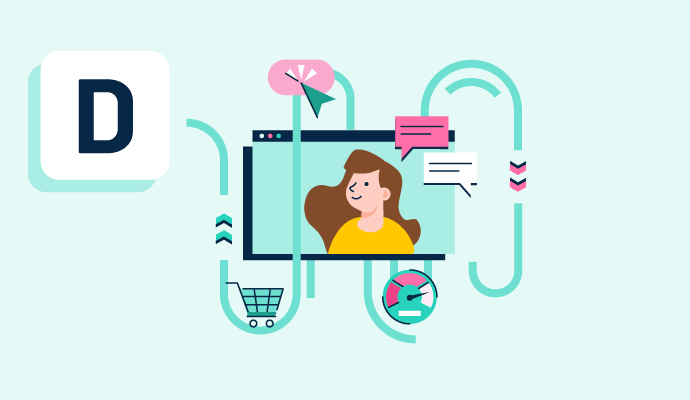What is a digital experience?
A digital experience is any interaction a customer has with a digital touchpoint for a business. This could be a website, a mobile app, a point-of-sale (POS) terminal, or a ticketing kiosk.
Data generated by these interactions is crucial for sales and marketing teams to gain insight into customer behavior. As part of an omnichannel experience, many of these touchpoints are managed through digital experience platforms (DXPs) to centralize this information for internal teams.
Through digital experience monitoring, companies can receive real-time data closely tied to business goals and key performance indicators (KPIs). This means that any action that needs to be taken to improve the digital experience for a customer can be completed as quickly as possible.
Types of digital experiences
Any interaction between a customer and a brand via a digital platform can be considered a digital experience. Some of the most common include:
- Landing pages. Customers browsing a business’s website are having a digital experience. Whether they’re looking for information or trying to make a purchase, how a customer feels about this interaction can significantly impact sales.
- Mobile apps. Like a landing page, a mobile app is also an important channel for customers to experience a brand. There should be consistency within the app to other marketing channels like social media or the business’s website to build trust and confidence for the customer.
- Customer portals. For existing customers, a portal containing information may not directly lead to additional sales. However, a good experience using the customer portal can lead to retention and long-term loyalty from a customer, making a well-functioning portal a worthwhile investment.
- POS systems. Customers who shop in a physical store may not have many digital interactions. But when they pay for their item, most current POS systems do more than simply allow the transaction to take place. Data can be gathered at this point in the customer interaction, both from the transaction and any additional features that can be provided, such as surveys or loyalty card scanning.
Basic elements of a digital experience
When thinking about a customer's digital experience, several key elements must be considered. These are:
- The user interface (UI). This is the front-end design of the digital platform being used. How the user interacts with the digital experience is determined by the design. Regardless of the medium, a good UI should always be easy to use and understand.
- The user experience (UX). While the UI defines the visual of the digital experience, the UX is focused on the quality of the interaction. Functionality features like accessibility, responsiveness, and intuitiveness all play an important role in whether or not the digital experience is good for the customer.
- The customer experience (CX). Both UI and UX are focused on more immediate interactions. CX, though, is long-term, looking at the overall lifetime of a customer’s digital experience. Developing loyal customers through good UI and UX creates a positive CX and increases the lifetime value of a customer to a business.
Benefits of a digital experience
In a highly digital world, providing customers with a good digital experience is no longer optional. There are plenty of benefits that come with digital experiences, including:
- Bridging the gap between online and offline. Customers now expect an omnichannel experience with most brands. For instance, restaurants using QR codes for menus and payments while a customer is dining in can use these digital platforms to seamlessly integrate both the offline and online experience of the brand.
- Increasing brand loyalty. A good experience often creates loyalty. Businesses can take this one step further through dedicated digital experiences that encourage loyalty, like frequent shopper points and loyalty programs.
- Gathering data for internal teams. The more insight the sales and marketing team has, the more effective their efforts can be. Gathering data through digital experiences can also allow these teams to personalize customer-facing content, further driving increased loyalty.
- Driving more revenue. With every digital experience, there’s a chance for a customer to make a purchase. From personalized recommendations via a landing page to a coupon after filling out a survey, every digital experience a customer has could ultimately lead to more money being made for the business.
Best practices for digital experiences
The goal of any digital interaction should be to improve the customer’s experience with the brand. When building new digital experiences, businesses should think about the following:
- Being available on multiple channels. Not every customer will be on every social network platform or use a mobile app. Having several digital channels running simultaneously means businesses can reach customers wherever they are and market more effectively.
- Using automation. Certain digital experiences can easily be programmed using artificial intelligence (AI) or algorithm-based technology. Customer support chatbots to answer basic frequently asked questions can save significant time and resources within the business while still giving customers 24/7 accessibility to information.
- Taking a mobile-first approach. E-commerce traffic continues to grow every year. Businesses should now consider the digital experiences customers have on smartphones as much as their desktop devices.
Learn more about the end-to-end customer digital experience using digital experience monitoring (DEM) software.

Holly Landis
Holly Landis is a freelance writer for G2. She also specializes in being a digital marketing consultant, focusing in on-page SEO, copy, and content writing. She works with SMEs and creative businesses that want to be more intentional with their digital strategies and grow organically on channels they own. As a Brit now living in the USA, you'll usually find her drinking copious amounts of tea in her cherished Anne Boleyn mug while watching endless reruns of Parks and Rec.

